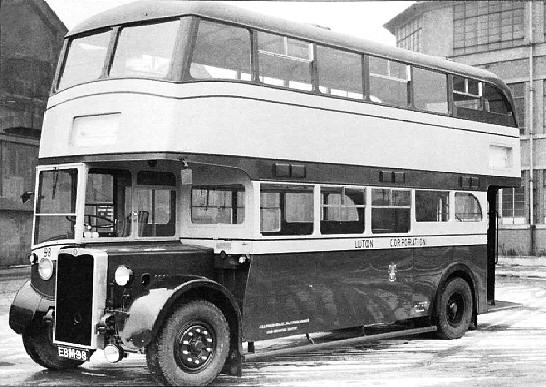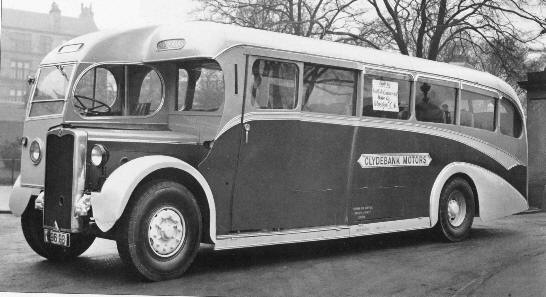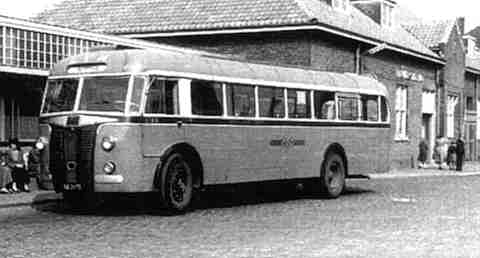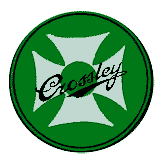The Crossley DD42 and SD42
Production of buses and Trolley Buses virtually ceased during World War II but design work went ahead on a new generation of buses for the post war world. Work on a new engine had actually started in 1938 under the leadership of Chief Engine Designer W. C. Worrall. Unfortunately, during the early stages of the work he became ill with tuberculosis and was sent by Sir Kenneth Crossley to Switzerland to recover. While there he visited the works of Saurer where he had worked before joining Crossley and saw their new direct injection cylinder head. He recognised this would be ideal for the new engine he was working on and sought permission to use it. By 1942 three prototype 8.6 litre engines, now called HOE7, had been built at Gorton and two new chassis prepared, one with a new body the other from a Mancunian and in 1944 this went on trial with Manchester Corporation. Performance was excellent and in 1944 the government gave permission for the production of 150 double decked DD42 and 80 bodies to proceed. A single decked SD42 had also been designed but this had to wait until after the war ended. A new body was designed in co-operation with Manchester using Crossley's metal framing system that had been under development since the late 1930s and the prototype was fitted to a Mancunian and sent out for testing. Visually it continued the design line that went back to the Streamliner but had a much larger windscreen and the rear two side windows had high sills which were needed to provide stronger supports for the rear platform which was reputed to carry large numbers of football supporters. Bodies to the same design were also made by Metro-Cammell and Brush.
At the end of 1945 production at the government Shadow Aircraft Factory No 5 at Erwood Park, adjacent to the old Willys Overland Crossley site, had finished and it was offered for sale. Crossley Motors entered negotiations and in September 1946 agreed to lease it for 10 years with an option to buy at the end of this period. In January 1947 the registered office was moved from Gorton and production transferred over the next six months. The old factories in Gorton were sold. The company had at last got space to expand and with a completely new chassis, body and engine and with war time damage to bus fleets to be made good prospects were excellent. First deliveries of DD42's had been made from Gorton in 1946 to customers in Bury (5), Leeds (1), Luton (8), Manchester (71), South Shields (6) and Stockport (1). Between 1945 and 1951 1,114 DD42's were made with Manchester (291) and Birmingham (270) being the biggest customers.

Body production using a design nearly identical to the one specified by Manchester also restarted in 1945 initially on Leyland PD1's and AEC Regals. Crossley bodies were always excellent, if expensive, and this was to become a very important work area and between 1945 and 1958 1,122 bodies were fitted to a wide variety of bus and coach chassis.
Single decker production for the home market started in 1947 with the SD42/3, at first to municipal operators but then increasingly to the growing private coach market, an area that had been largely untapped pre-war. In the end 620 out of a total of 1680 SD's went to independent operators.

However, problems soon arose with the new HOE7 engine. A dispute over royalty payments with Saurer resulted in a rapid redesign of the cylinder head which resulted in an engine that never "breathed" properly. The new design also ran hotter, was down on power, was less economical on fuel and had a greater appetite for engine oil than the original version. The problems were not resolved until 1949 when following the AEC takeover a new downdraught head was introduced but by then major damage to Crossley's reputation had been done. The bottom end was successful though and the pre-war crankshaft and bearing problems were conquered. Also the new chassis was excellent, running very smoothly and the synchromesh gearbox was one of the best available.
The Crossley Dutch buses
Orders for complete buses and bodies continued on a large scale as most fleets had been worn out during the war and in 1945 came what was Crossley's and possibly up to then Britain's biggest export order for buses when Netherlands Railways placed a 33,000,000 order for 1175 vehicles made up of 425 two axle 32 ft 11 inch long chassis for single deck 43 seat bodies, a further 500 at 35 ft 2 inch length for 47 seat bodies, both 8 feet wide, and 250 17 ft 11 inch tractor units for articulated buses. The articulated units would use locally built trailers to carry 52 seated and 28 standing passengers.
First deliveries were the tractor units, really shortened DD42's and these went to DAF for the trailer chassis and then to a local builder to have bodies fitted. The HOE7 engine was used but with a cross flow head that worked better than the standard version. These vehicles were intended as a stop gap until bus production proper started and by 1951 most had left passenger service. Some were sold to East Germany where they continued in use until 1965.

Deliveries of the 47 seater bus chassis, designated SD42/1 started in early 1947. It was actually larger than the then current British regulations permitted and the specified maximum speed of at least 60 mph for the buses was also higher than normal UK requirements. In order to achieve this speed with the larger chassis Crossley's HOE7 8.6 litre diesel engine was fitted with twin Roots superchargers which boosted power from 100 bhp to 150 bhp at 1800 rpm and was designated the HOE9. The supercharged engine was not a success suffering from lubrication problems and the superchargers were soon removed but fortunatrely the standard engine proved adequate. A substantial 5 speed gearbox was also developed and mounted mid chassis separately from the engine. Stopping power was by 16 1/2 inch by 6 inch brakes and it was specified in the contract that assistance was to be by the Westinghouse air pressure system as opposed to Crossley's normal vacuum system.
The short chassis SD42/2 arrived from mid 1947. Most were bodied by Dutch companies but 150 were supplied with Crossley bodies. Local bodies could be grouped into two types with the doors in front of the rear axle or just behind the front one. Some of them were used on the long distance Europabus network.
Most of the buses lasted into the 1960s with final withdrawal in 1965. At least one has been preserved.
The Crossley Dominion and Empire Trolley Buses
Trolley Bus production also restarted in 1948 even though the days for these vehicles were now numbered. In 1950 two new double deckers, the 30 feet long three axle TDD64 "Dominion" and the 26 feet long two axle TDD42 "Empire", were launched powered as before the war by Metro-Vickers motors. Orders were received from Ashton under Lyne, Manchester and Cleethorpes and also export orders for 33 feet long single deckers for Wellington and New Plymouth in New Zealand. Production continued until 1958 with a final order for bodies fitted to BUT chassis for Glasgow. Total post war chassis production amounted to 75, consisting of 45 TDD42's, 16 TDD64's and the 14 single deckers for New Zealand. With the 110 made pre-war total number of trolley bus chassis made was 185.

The trolley buses were delivered to their customers, or the docks, by being towed by either a pre war Beta or one of the two prototype post war lorries.
By the end of the 1940s the post war boom was coming to an end and company rationalisation and mergers were starting throughout the industry. It was clear that Crossley was too small to survive on its own and in 1945 the board decided to look for a partner or buyer. Discussions at first were with Maudsley but in 1948 the Crossley board decided to sell to AEC who at the same time took over Maudsley. The new holding company became known as ACV (Associated Commercial Vehicles). Trading conditions for the whole industry were becoming more difficult and the supply of raw materials was still restricted by the Ministry of Supply. Crossley prices were also up to 20% higher than those quoted by their competitors. The market for the successful SD42 coach business was also hit when regulations changed in 1950 allowing 30 foot long bodies. The front engined layout was becoming obsolete as well so the lengthened SD42 which was offered was not what the market wanted
Rationalisation, Merger and Closure
New orders were becoming scarce and the machine shop took on general work to keep going but there were redundancies elsewhere. Some work continued for other parts of ACV such as trucks for Egyptian Railways and some trolley buses but in 1951 it was decided to stop selling the Crossley chassis. Any customers would now be offered AEC or Maudslay designs and the last genuine Crossley was constructed in August 1953 for Rotherham Corporation. From then onwards it was badge engineered AECs that left the Erwood Park factory. Body production did continue and ACV directed an order for military bodies to the factory and gearbox production kept the machine shop busy.
There was a final order for some railway bodies but it was obvious that the end was coming. There was an exodus of skilled staff and in 1958 the Errwood Park plant was declared surplus by ACV and closed down. The final bus bodies were still in manufacture for Stockport and these were accepted part-built with Stockport hiring some ex-Crossley employees to complete them.
The last Crossley bus in service is believed to have been with Blackburn in the late 1970s and a handful have been preserved. In total 5,500 buses and bodies left the Gorton and Stockport factories.
Renaissance? - Leyland National
There is however a final twist. In 1962 ACV and AEC became part of their old rival Leyland Motors. In 1969 a new venture to make single deckers, was formed and Leyland found they had a company that had never been closed down - Crossley Motors Ltd so they renamed it Leyland National. Leyland National then built 7700 buses in Workington between 1972 and 1985. Ironically these had sturdy long lasting bodies but an unreliable engine. The company was renamed again twice and not finally wound up until 1992.
